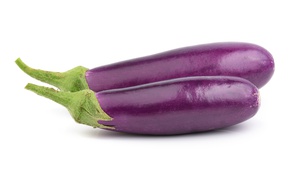
AUBERGINE – EGGPLANT
Aubergines come in small and large sizes, speckled or one color, in white to deep purple, almost black. The white version is the reason why this vegetable is also known as "eggplant".
Aubergines are used a lot in India, China and around the Mediterranean. The white flesh needs to be cooked to be at its best but when cooked correctly it’s delicious and adds a rich texture to everything from pasta sauces to dips.
Remember that aubergines can take a while to cook through. Semi-raw aubergine is not a particularly nice experience.
Choosing aubergines
Look for smooth skins without light brown parts or soft patches.
If you are making moussaka: Choose extra thick and/or extra long aubergines that you can slice to make good layers in your baking dish.
Storing aubergines
It’s best to keep them in the original packaging. The material and the design will have been produced to keep the contents fresh for as long as possible.
Aubergines are best when kept in a cool but not a cold place. About 8°C is a good temperature.
Preparing aubergines
When frying aubergine, slice it or dice it – whichever you prefer – and salt for a while in advance to draw out some of the liquid. That will make the flesh firmer.
The salt also draws out some of the natural bitterness of this vegetable which would otherwise impair the flavor.
How to cook aubergine
Aubergine needs cooking, ideally slowly for a long time so it’s completely done. You can also steam aubergine Chinese style and then marinate it. Or put together a Greek moussaka for Sunday lunch.
Make a dip: Its velvety texture makes oven-baked or fried aubergine a good base for dips such as baba ganoush. Make your own meze with garlic, chili, cumin and tahini.
Oven bake whole: One good way of getting to the delicious flesh inside the aubergine is to bake it whole in the oven. Prick some holes in it with a fork, place on a rack and set the oven to a medium heat so that nothing burns. After approximately 45 minutes the aubergine will be soft all the way through (feel it to check) and you can slice it and scrape out the almost cooked “dip”. Just add flavors...
Fried aubergine can be ideal in casseroles, like the classic vegetable stew ratatouille, and in a chunky tomato sauce for pasta.
Oven-baked aubergine is good as it is: Cut the vegetable into cubes approximately 2 x 2 centimeters in size and spread them out on a baking sheet with a little oil, sea salt and fresh rosemary for example. Bake in the oven at about 190°C until the cubes have taken on a little color and are soft all the way through.
Steamed aubergine is a Chinese side dish that’s ideally made from aubergine with a thin skin, but you can steam ordinary aubergine too. It takes about 15 minutes, and afterwards you marinate it in soy sauce, rice wine vinegar, garlic and sesame oil. Leave to soak in the flavors before it melts in the mouth.
Deep fried aubergine. Slice crosswise or lengthwise and deep fry.
Serving aubergine
Aubergine doesn’t look particularly attractive and it can go a bit grey when cooked. Use fresh herbs such as mint and flat leaf parsley to make a better first impression.
An aubergine dip doesn’t look that appealing either. Improve the look with a pinch of paprika and a few drops of a good, glistening green, olive oil.
Tomato goes well with aubergine and will add a little color too.
The classic
The aubergine dip Baba ganoush with garlic, chili, cumin and tahini. A perfect meze with a bit of good bread.








